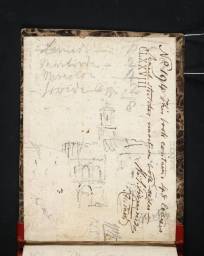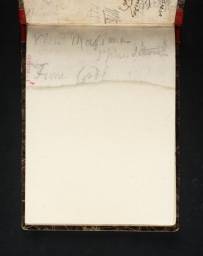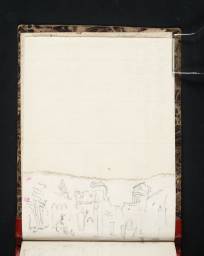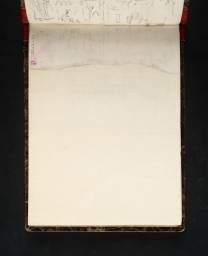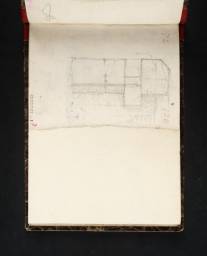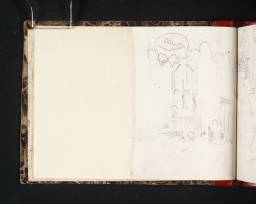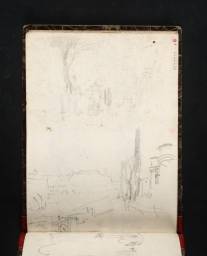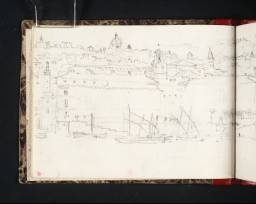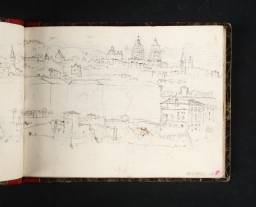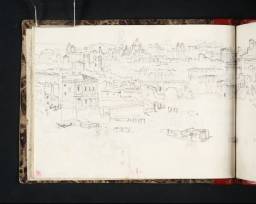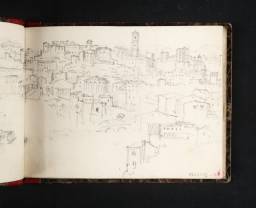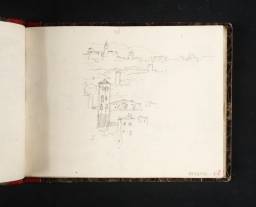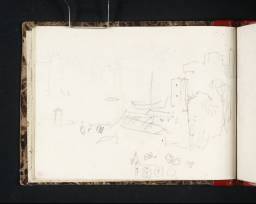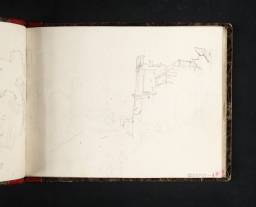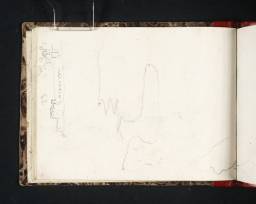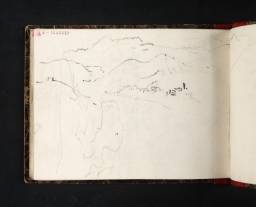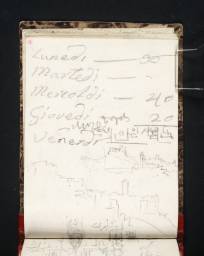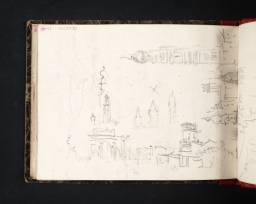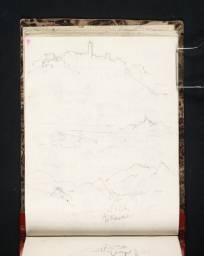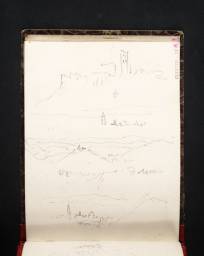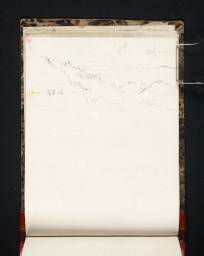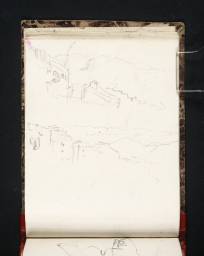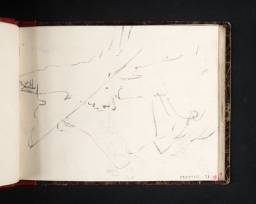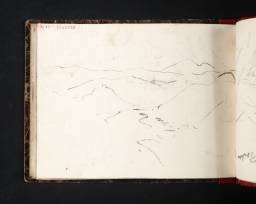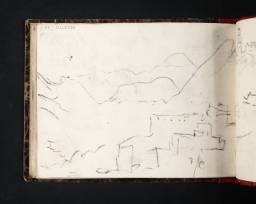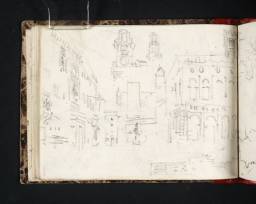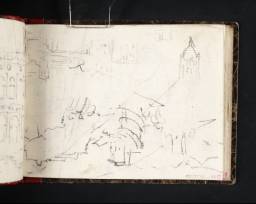Turner Bequest CLXXVIII 1–55a
Sketchbook bound in boards, covered in marbled brown paper, quarter-bound over red leather spine
55 leaves and paste-downs of white laid paper; page size 97 x 132 mm
Numbered 194 as part of the Turner Schedule in 1854 and endorsed by the Executors of the Turner Bequest inside front cover (D40671)
Stamped in black ‘CLXXVIII’ on front cover, top right
55 leaves and paste-downs of white laid paper; page size 97 x 132 mm
Numbered 194 as part of the Turner Schedule in 1854 and endorsed by the Executors of the Turner Bequest inside front cover (D40671)
Stamped in black ‘CLXXVIII’ on front cover, top right
Accepted by the nation as part of the Turner Bequest 1856
Exhibition history
References
Turner used this sketchbook during his second major tour of France and Italy in 1828–9, as one of eight associated with this journey (see the overall tour Introduction). The sixth book in the sequence, it is also the first covering the return leg of the journey from Rome. According to Turner’s brief notes inside the front cover of the Rome, Turin and Milan sketchbook (Tate D41050; Turner Bequest CCXXXV), he departed from Rome on Saturday, 3 January 1829. Continuing the itinerary covered by the Viterbo and Ronciglione sketchbook (Tate; Turner Bequest CCXXXVI), which concludes in Rome, this sketchbook covers a substantial stretch of inland and coastal roads across much of present-day Umbria, Marche and Emilia-Romagna.
The title ‘Rimini to Rome’ was applied by Finberg in his 1909 Inventory of the Turner Bequest.1 Incorrectly dating the book to 1819, Finberg associated it with Turner’s first major tour of Italy in 1819–20, when he travelled from Venice to Rome via Ancona.2 The first part of this route was recorded in the Venice to Ancona sketchbook (Tate; Turner Bequest CLXXVI), and the second part in the Ancona to Rome sketchbook (Tate; Turner Bequest CLXXVII); see the respective introductions by Matthew Imms and Nicola Moorby in the present catalogue. By the time he published In Venice with Turner in 1930, Finberg had realised his error, reallocating the sketchbook to the return leg of Turner’s later tour of 1828–9,3 and in his subsequent Life of the artist, he noted: ‘The sketch-book ... was placed with the 1819 sketches by mistake [in 1909], and its present title should be altered to “Rome to Rimini”.’4 In the present catalogue, Finberg’s revised title has now been adopted, both to clarify Turner’s direction of travel and to associate this book firmly with his 1828–9 Italian tour.
Finberg’s initial error was no doubt due to the geographical overlap between the three sketchbooks: many of the towns and cities depicted in the earlier Venice to Ancona and Ancona to Rome sketchbooks also reappear in Rome to Rimini, albeit in a more illogical order. Among them are Narni, Terni, Macerata, Recanati, Loreto, Osimo, Ancona, Pesaro, Rimini, Bologna and Piacenza. Turner produced comparatively few sketches of these sites during his second Italian tour, presumably seeing little reward in repeating his earlier efforts. Equally, as Powell has observed, the artist did take time to sketch specific subjects already familiar to him from 1819: the Arch of Augustus in Rimini, for example, or the Piazza Nettuno in Bologna.5 The route embodied by much of this sketchbook follows the Via Flaminia, an ancient road connecting Rome to Rimini via the Apennine Mountains.
Compressing a significant distance into fewer pages, Rome to Rimini appears a sprawling and disorganised sketchbook when compared alongside Venice to Ancona and Ancona to Rome. It lacks the geographical cohesion of these two earlier sketchbooks, and is similarly inconsistent in the number of sketches devoted to each location. Cecilia Powell has aptly described Turner’s progress during his return journey as ‘somewhat erratic’.6 This is partly apparent in the uneven pace of Turner’s sketching practice: there are hardly any studies of locations between Rome and the area around Macerata, Recanati and Loreto, ‘which suggests that Turner was perhaps travelling by night as well as by day in the early stage of his journey’.7 On reaching the Marche region, he then executed several rough sketches in rapid succession.
The content of Rome to Rimini illustrates the topographical variety Turner encountered along his journey, from the mountainous terrain of the Umbrian Apennines to the hilly landscapes of Marche and coastal views of the Adriatic Sea near Ancona and Rimini. A fellow traveller from this period wrote to the artist Thomas Uwins describing Turner’s sketching practice, observing how the artist was ‘continually popping his head out of [the] window to sketch whatever strikes his fancy, [...] [becoming] quite angry because the conductor would not wait for him whilst he took a sunrise view of Macerata’.8 The same traveller also remarked on Turner’s ‘indefatigability in his favourite pursuit’.9
The ‘somewhat erratic’ appearance of Rome to Rimini is also likely explained by the bleak and hazardous conditions in which Turner worked. Departing from Rome in early January, he experienced heavy ice and snow for much of his return journey – an experience he recounted several weeks later in a letter of 16 February to his friend Charles Eastlake:
Now for my journey home. Do not think any poor devil had such another, but quite satisfactory for one thing at least, viz. not to be so late in the season of winter again, for the snow began to fall at Foligno, tho’ more of ice than snow, that the coach from its weight slide about in all directions, that walking was much preferable, but my innumerable tails would not do that service so I got wet through and through, till at Sarre-valli [presumably Serravalle di Chienti] the diligence zizd into a ditch and required 6 oxen, sent three miles back for, to drag it out; this cost 4 Hours, that we were 10 Hours beyond our time at Macerata, consequently half starved and frozen we at last got to Bologna, where I wrote to you. But there our troubles began instead of diminishing – the Milan diligence was unable to pass Placentia [Piacenza]. We therefore hired a voitura, the horses were knocked up the first post, sigr turned us over to another lighter carriage which put my coat in full requisition night and day, for we never could keep warm or make our day’s distance good, the places we put up at proved all bad till Firenzola [presumably Fiorenzuola d’Arda, near Piacenza] being even the worst for the down diligence people had devoured everything eatable (Beds none) [...] from Foligno to within 20 miles of Paris I never saw the road but snow!10
The title Rome to Rimini does not encompass the full geographical scope of the book; while many locations lie between Rome and Rimini along the Via Flaminia, there are also several views of Bologna and some of Reggio Emilia and Piacenza from later in Turner’s itinerary, once he had turned inland towards Milan. Turner recorded inside the front cover of the Rome, Turin and Milan sketchbook(Tate D41050; Turner Bequest CCXXXV) that he reached Bologna on Tuesday (6 January 1829), having departed from Rome on 3 January. The present sketchbook was therefore filled within this brief interval of just a few days.
In his survey of the Turner Bequest, John Ruskin noted down his poor assessment of this sketchbook on the enclosing wrapper (since lost, like many others), dismissing it as ‘Late. Valueless, except one of Genoa.’11 Genoa does not appear in this sketchbook, leading Finberg to suggest, in consultation with fellow Turner scholar C.F. Bell, that Ruskin was perhaps referring to Ancona.12
Technical notes
How to cite
Hannah Kaspar, ‘Rome to Rimini Sketchbook 1828–9’, sketchbook, November 2024, in David Blayney Brown (ed.), J.M.W. Turner: Sketchbooks, Drawings and Watercolours, Tate Research Publication, February 2025, https://www

